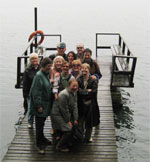Almost Twenty Years of Existence
The AIZEN is about ready to celebrate twenty years of existence since this International Association for Multidisciplinary Approaches and Comparative Studies related to Émile Zola and his Time, Naturalism, Naturalist Writers and Artists, Naturalism and the Cinema around the World was founded by Monique Fol in 1991. The main purpose of this scholarly society was to provide a forum for the worldwide expansion and promotion of Zola and Naturalist studies. So far, fifteen international conferences have been held to accomplish this goal, where international and independent scholars, new researchers and well-known specialists, doctoral candidates and other interested individuals have debated the results of their research, taken stock of prior research, and set new objectives. In addition, as a result of our international conferences, we have been able to discover and enable new talent to surface, especially through the AIZEN Schor/Cahm Award for the best paper given by a doctoral candidate which was created in 1995. Nevertheless, each conference has had a character all its own, depending on the location, the local organizational committee, and the focus on specific topics in the various sessions. Over these nineteen years, our conferences have drawn approximately 875 participants. These events have taken place in fourteen cities and six different countries (the U.S., Scotland, Canada, Brazil, Spain, and Finland) and on three continents.
The results of our members’ high-caliber research were published in Excavatio, the international scholarly journal sponsored by the AIZEN. Researchers have, first of all, traced the concept of naturalism and its convergences and divergences in variants throughout the world – that is, not only in Western Europe, but beyond these familiar borders, extending them, in particular, to Scandinavia and North and South America – revealing specificities that broaden and modify the original idea on the basis of unique social and cultural contexts. Second, our contributions have applied new theories and experimental approaches to Zolian naturalism, which includes the members of his immediate circle, with the result that textual phenomena and dynamics have been discovered, bringing to light new dimensions and facets of this author’s impressive life work. Third, our research has emphasized less explored areas of Zola and Naturalist Studies, with our emphasis on the visual, including studies of paintings by Impressionists and Post-impressionists, but, in particular, the accent has been placed on cinema. One entire special issue of Excavatio was devoted to “Naturalism and Realism in Film Studies” (vol. XXII, 2007), with Anna Gural-Migdal and Robert Singer as co-editors.
The next AIZEN Conference: Pusan, South Korea – 2011

City of Pusan, South Korea
To fulfill its mandate of promoting Zola and Naturalist studies around the world, the AIZEN has decided to celebrate its twentieth anniversary on yet another continent: East Asia. This will represent not only an expansion for the AIZEN, but also an ideal location to keep us in step with the current societal move toward globalization. Furthermore, Asian influences were fashionable in Europe during the last quarter of the nineteenth century, when Impressionism in the plastic arts and Naturalism in literature were gaining a foothold. It seems fitting that an international conference, entitled “Worldwide Naturalism in Literature and Film,” to take place in an important city at the crossroads of Asia – Pusan, South Korea –, will mark twenty years of the AIZEN. The conference, to be held from October 6 to 8, 2011, will be jointly organized with the Pusan National University in conjunction with its Department of English Language Education, College of Education, and its Film Institute. These connections will enable us to capitalize further on areas that have distinguished us in the past and move us into the very rich arena of Asian literature, art, and film. As we break new ground, we will enjoy an excellent opportunity to include festivities marking the AIZEN’s twenty-year milestone.
A number of themes for the conference will explore cross-fertilizations between Asia and Europe, as they relate to Zola and naturalism, with special sessions bearing such titles as The Reception of Emile Zola in Asia, Asian Influences on French Naturalist Writers, Comparative Approaches to Asian Naturalist Texts, and South Korean Naturalism. There will also be sessions focusing on naturalism and neo-naturalism in the Americas and Europe from the end of the nineteenth century to the present, with the possibility of sessions and panels on specific authors or countries. Please consult the Call for Papers for details.
Since the 1990s, South Korea in particular has become known for its vibrant national film industry. This situation came about as the result of three factors. First of all, support for the development of Korean cinema was provided by industrial and financial groups; secondly, the success of the exceptional art film dealing with traditional Korean singing, The Pansori Singer (1995), by Kwon-Taek Im, brought commercial triumph and international acclaim; and, thirdly, the Pusan International Film Festival (PIFF) came into existence. Since then the works of many other Korean filmmakers, amongst those from other countries, have gained world attention as a result of their exposure at this festival. Korean cinema in particular offers an entire spectrum of genres, including astonishing examples of naturalist film.
In fact, the AIZEN conference will be held concurrently with the Pusan International Film Festival (PIFF), and will therefore allow naturalist cinema to receive special emphasis. There will be several sessions for which papers having to do with film will be welcome. The topic Naturalism in Asian Cinemas, will allow for sessions to form around more specific issues related to filmmakers and national cinemas. More usual AIZEN sessions encouraging papers related to film will also be offered, for example Film Adaptations of Naturalist Novels and Zolian Fiction as Document/ Documentary. During the AIZEN Naturalist Film Festival, participants will be able to view contemporary examples of Korean naturalist film.
Our guests for this conference will include renowned French specialist in Zola and naturalism from the Université Paris III-Sorbonne Nouvelle and Director of Les Cahiers naturalistes, Alain Pagès, and Myung-Hwan Jung, Professor Emeritus of French Literature, a member of Korea National Academy and a great specialist in Zola. There will be other scholars of naturalist literature and film, not only from Korea, but from other East Asia countries as well. We also expect to be honored by the presence of the most famous Korean filmmaker Kwon-Taek Im, who was awarded the prize for best director at the 2002 Cannes Film Festival and the Honorary Golden Bear Prize in 2005 at the Berlin film competition. Presently, he is Dean of the Film Academy at Dongseo University, in Pusan. He has been invited to give a talk on the history of naturalist tendencies in Korean cinema and will offer for our consideration specific features of contemporary Korean cinema, terming its style “radical realism.”
Familiarizing ourselves with South Korea and, in particular, with the city of Pusan will be an exceptional experience for all. In an enthusiastic article entitled “After Beijing, why not visit South Korea?” Sang-Koo Kim listed the advantages of visiting his country, as Guest Commentator for UPI Asia/Pacific On-Line Service:
“However, if visitors decide to travel to nearby Asian countries, such as South Korea and Japan, they will discover different wonders and mysteries. For these nations have many surprising attractions quite different from Beijing or Shanghai. For example, Seoul, the capital of South Korea – like Tokyo, Osaka and Kyoto – is less than one hour from Beijing by plane. Even Busan, the second largest city of South Korea, a very beautiful harbor at the southern edge of the Korean peninsula, is located only a few hours from Shanghai by cruise ship. There are many modes of transportation, including planes, cruise ships and ferries, between South Korea and China.
Busan, to say nothing of Seoul, has its own unique history, natural comforts and natural resources, especially the blue skies that, currently and throughout the autumn, show no hint of clouds. Furthermore, on three sides Busan is surrounded by the wide open Pacific Ocean, with the northern part being mountainous. The spectacle is very beautiful and sublime. Busan, located in a harbor and with a population of over 3.5 million people, is known as one of the world’s largest trading ports. It is about 40 minutes by car from both the most famous and one of the largest shipbuilding industrial complexes in the world: Daewoo and Samsung. The road between them is mainly linked by bridges. […]
A 30-minute drive along a winding mountain road, with high cliffs on one side and the vast Pacific Ocean on the other, allows visitors to view the Woryook Islands – the name means “five or six,” as you can see five or six islands depending on the weather – and even the tip of the Japanese islands. Moreover, if visitors have time to enjoy a moonlit night at the Haeundae Beach Resort located at the southeastern edge of Busan, they will have an unforgettable memory. They will be able to enjoy the moon in the bluest sky on the very wide and long beach, which has the longest collection of beach umbrellas in the world […]. The moon is beautiful when it is reflected on the night sea. […] Haeundae Resort is the very place to make dreams come true. Korea extends a heartfelt welcome to visitors to come and discover their dreams.”
(http://www.upiasia.com/Society_Culture/2008/08/22/after_beijing_why_not_visit_south_korea/4695/)
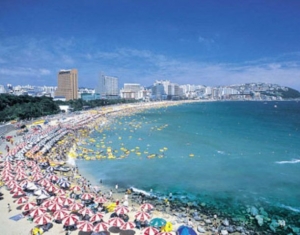
Haeundae Beach Resort, Pusan
Today the city is a centre for international conventions and sporting events. In October, Pusan attracts numerous moviegoers from around the world through its annual Pusan International Film Festival, which kicks off with world-famous fireworks at its opening ceremony. This event is recognized as one of the five major international film festivals. Furthermore, the city is home to the Pusan Biennale, a world-renowned international contemporary art festival. In Pusan there are also various historic and cultural heritage sites, as well as rare Buddhist temples.

Pusan International Film Festival
The AIZEN conference will take place at Pusan National University, one of the most highly recognized national institutes of higher education in the Republic of Korea and a top research institution covering all the major disciplines in academia. Established in 1946 with only two faculties (Humanities and Fisheries), it now comprises fifteen colleges, one independent division, one general graduate school, four professional and five special graduate schools. In 2008, its total enrollment was almost 28,000. We are pleased to be working with Emeritus Professor Sang-Koo Kim, a renowned specialist in American Naturalism from Pusan National University. We are also delighted to collaborate with Professor Wang-Joo Lee, Director of the Film Institute and Professor Il-Jae Jo, Chair of the Department of English Language Education in the College of Education.

Pusan National University Campus
The Pusan National University campus is located in a lively part of town, with student theaters, cafes, bars, restaurants, and street performers. The conference sessions will take place in Induck Hall and Main Hall, this latter completely equipped with audio-visual facilities for plenary sessions and film screenings. Participant presentations will be held in classrooms with a capacity of 40-50 persons. Since this will be an open conference, students at the University and from other universities in Pusan will be welcome to attend the sessions and the Naturalist Film Festival.
Many festivities will be organized in conjunction with the conference, in particular cultural and social events. Receptions will be offered by the Mayor of Pusan and the President of Pusan National University. During the ritual Naturalist Banquet our members will enjoy traditional Korean food and drink. And the AIZEN will sponsor a special cocktail party to celebrate its twentieth anniversary! We are pleased that the city will offer a literary tour or a visit to Kyungloo and its ancient ruins. Since the AIZEN conference will be running concurrently with the Pusan International Film Festival, an important attraction in itself, the post-conference tourist activities will focus on this event.
Rooms will be available for doctoral students at Pusan National University, for approximately $48.00 per person per night. We plan to reserve a block of forty rooms for participants at the Hotel Nongshim, only ten minutes from Pusan National University. This five-star hotel is located near many famous points of interest, parks, and an express bus terminal. Hotel Nongshim has had a reputation for its friendly service for forty years, but was recently rebuilt and renamed. It was one of the first resort hotels in South Korean below the Han River, located near the Dongnae hot springs. To this day, water from the hot springs is available in every one of its 242 rooms. It has a number of restaurants serving excellent food: Korean, Turkish, and Japanese. In fact, the hotel has become a popular place to hold celebratory dinners for large groups – family or otherwise. In addition, the hotel boasts a coffee shop, a huge bakery, a bar, and a spa with a fitness centre and elaborate hot springs facilities.

Hotel Exterior

Hotel Surroundings
The price at Hotel Nongshim for deluxe rooms for two – with double or twin beds – will be about $140.00 per room per night, including 10% each for tax and service. These rooms are equipped with telephones, TV (with channels in English, Japanese and Chinese, and others available via satellite and cable), internet, mini-bar, and hair dryers. Laundry service is available during business hours.
The conference will be sponsored not only by the AIZEN and the Pusan National University, but also by the City of Pusan, the Pusan Convention Bureau, the Korean Research Foundation, the American and French Cultural Centers, not to mention scholarly societies such as the Société Coréenne de Langue et Littérature Françaises. We most heartily thank Pusan National University, the Film Institute and its Director, Professor Wang-Joo Lee, the Department of English Language Education and its Chair, Professor Il-Jae Jo, and especially Professor Sang-Koo Kim whose inspiration and energy have made the realization of this collaborative project possible. Thank you also to the members of the Association who are part of the Organizational Committee for this conference: Professors Anna Gural-Migdal (Canada), Carolyn Snipes-Hoyt (USA), Jeremy Worth (Canada), Ligia Vassallo (Brazil), and Dr. Riikka Rossi (Finland). We look forward to receiving your proposals for challenging papers by January 31, 2011.
Conference Report: Helsinki
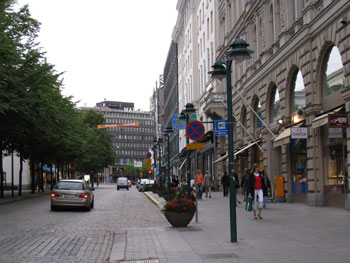
City of Helsinki, Finland

City of Helsinki, Finland
For the first time our Association held its last conference in a country of Northern Europe. Titled “Women under Construction: Female Representations in Nineteenth-Century French and Scandinavian Realism and Naturalism,” this event was jointly organized by the AIZEN and the University of Helsinki and took place on August 14-15, 2008. French naturalism had a significant impact on Finnish writers of the nineteenth century and well-known and lesser known naturalist novels in Finland were authored by female writers such as Minna Canth and Ina Lange who documented and represented the least savory aspects of life for women in order to challenge an idealized nationalist view of the female sex in this country; for these reasons, the choice of the University of Helsinki as a conference site could not be more appropriate.
The Department of Finnish Language and Literature at the University of Helsinki has an international reputation and has developed a strong profile, especially in period- related concepts of literature. We are pleased that such a highly regarded department in a leading European University offered to host the conference. Furthermore, the Finnish Graduate School of Literary Studies and the Department of Finnish Language and Literature, including the prestigious Academy of Finland, joined the AIZEN in sponsoring the event, an invaluable collaboration for which we are grateful.
The gathering featured specialists in the representation of women, in the areas of French or Scandinavian realism and naturalism, from eleven different countries: England, Denmark, Finland, France, the Netherlands, Iceland, Italy, Norway, Sweden, Canada, and the USA. Single sessions were scheduled so that everyone could hear all the speakers. The topics covered included works by French or Scandinavian writers such as Balzac, the Goncourts, Zola, Rachilde, Canth, Sigurðardóttir, Ibsen, Benedictsson, Skram, Lange, and Onerva. Participants were especially made aware of the wealth of Finnish literature during the turn-of-the twentieth century period, a cultural treasure unknown to most other westerners.
On the first morning of the conference, in a plenary session, we were delighted to listen to Special Guest Speaker Päivi Lappalainen (University of Turku, Finland) give a talk entitled “Seduced Girls and Prostitutes: The Character of the Fallen Woman in Naturalist Fiction,” in which she emphasized the unique aspects of Finnish female characters in these works, and offered interpretations that connected them to contemporary concerns. A recast version of this paper is published in volume XXIII of Excavatio. Honoured Guest Speaker Anna Gural-Migdal (University of Alberta, Canada), challenged us with a talk entitled “La dimension épique des femmes dans Germinal de Zola.” In this paper, the President of the AIZEN put forward the idea that women in this novel defend their own collectivity, the mining community. The strike serves as a trigger element that moves the “family” group to the tribal stage, a new level of community consciousness that awakens the creative resources and heroism of women. Following these two signature presentations, there were sessions as well on Ancestors and Descendants of Realist Female Representation, Zolian Women Outside the Rougon-Macquart series, and Classics of Female Representation in French and Scandinavian Naturalism.

From left: Morten Nøjgaard, Anna Gural-Migdal, Päivi Lappalainen
The second day of the conference began with a session that again brought the two naturalisms together and focused on the main theme of the conference: The Constructedness of Naturalist Female Figures. During a second plenary session, Special Guest Speaker Morten Nøjgaard (University of Odense, Denmark) presented a stimulating paper entitled “Splendor corporis, splendor veritatis? Le corps féminin comme démonstration ou subversion de la vérité,” in which he examines the nature of the “truth” inherent in specifically naturalist representations of women’s bodies, contrasting them with romantic and realist depictions. A recast version of Morten Nøjgaard’s paper has been included in volume XXIII of Excavatio. Honoured Guest Speaker Carolyn Snipes-Hoyt (Pacific Union College, USA) gave a paper titled “‘L’héroïne simple’ in Émile Zola’s La Joie de vivre.” in which she showed how a number of representational devices used in this novel to evoke the main female character, considered by some critics to be “allegorical,” recall female Republican imagery prevalent during the period, thereby suggesting a more political interpretation of her role in the novel than has previously been allowed. The afternoon sessions dealt with The Trappings and Implications of Female Representation in French Naturalism and Nervous and Neurotic Women in Fin-de-Siècle Decadence.

Carolyn Snipes-Hoyt
Conference-goers came away from this gathering with a very positive impression of Finnish hospitality, congeniality, and culture. We were treated to Finnish pastries, fresh fruit, coffee and good-natured conversation during breaks between sessions in the intimate atmosphere of the Department of Finnish Language and Literature. During the Opening Cocktail, which was held in the same space, we had the pleasure of tasting Finnish specialties, such as the famous tiny pastries from Karelia and a special northern cheese to be eaten topped with a dollop of delightful cloudberry jam. In high spirits, participants conversed animatedly, thrilled to be able to share their joy in coming together, many for the first time. Amidst a tumult of talk and laughter, all gathered around a large table, raising their glasses of champagne several times to toast the graciousness of our hosts with a “Kippis!” as is the tradition in Finland.
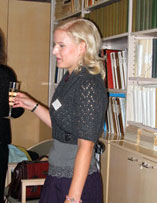

Left: Riikka Rossi
Right: Welcome Cocktail party
The evening ended with the projection of the film Juha, an excellent melodrama by Aki Kaurismäki (1999, Finland, 78 min.). Adapted from a Finnish naturalist novel by Juhani Aho, this film tells a cruel, touching story of love, loss, and revenge. A farmers’wife is seduced into running away from her stolid older husband by a city slicker, who enslaves her in a brothel. Juha has been cited as the “last silent film of the twentieth century.” While Juha is filled with allusions to masterpieces of silent film, Kaurismäki nevertheless escapes descent into pastiche. The scene where the husband drops off his wife at a brothel in fact returns to the theme of exploited innocence that is also to be found, for example, in The Two Orphans by D. W. Griffith and Foolish Wives by Stroheim.

Juha by Aki Kaurismäki
Both days of the conference, participants continued their discussions of papers during lunch at Restaurant Aino, where typical Finnish dishes were prepared and served with elegance. The crowning moment of our experience with Finnish cuisine, however, was the Naturalist Dinner. This AIZEN ritual dining took place in the iconic Restaurant Kappeli, on the esplanade that reminded newcomers of a calmer, more intimate Champs Elysées. The ultimate in “camp,” the Kappeli is all glassed-in for watchers of the midnight sun in summer or the aurora borealis in winter. The menu proved to be an over-the-top array of gourmet delights: the first course consisted of strips of salted reindeer meat and forest mushroom salad served on a Karelian pasty; wild mushroom soup was served as a second course, with dark rye bread; grilled Pollan, with mustard and thyme sauces, seasonal vegetables, and creamy pureed potatoes made up the main course. All was washed down with glasses of Vina Morande and accompanied by animated conversations amongst participants, during which friendships were forged or reinforced. For dessert, we enjoyed a delectable panna cotta topped with fresh raspberries, served with coffee or tea.


Naturalist Dinner, Restaurant Kappeli
Participants were grateful for all the planning that went into this brilliant event and especially indebted to Anna Gural-Migdal and Riikka Rossi, who brought to fruition this gathering of specialists in Scandinavian and French realism and naturalism, with emphasis on the representation of women, a project requiring eighteen months of preparation. Throughout this period, the organizers were assisted by Virve Miettinen. In addition to planning the social events and assuring the smooth functioning of the conference in general, Virve Miettinen was responsible for the production of the program: engaging artist Mirkka Eskonen, overseeing the graphic design, and printing the final version.With its feminine subject, woodcut technical style, and traditional Scandinavian simplicity, the program deserves unqualified praise as unique in the annals of the AIZEN. A big thank you to graduate student Laura Forsström, who helped Riikka Rossi and Virve Miettinen, Assistant Organizer, in making sure the events of the conference, and related activities, would move forward in an orderly fashion. Laura’s excellent photos, taken during the entire conference, were used to illustrate the electronic program and the present AIZEN Bulletin, as well as make up the photo album of the conference. All are posted on our web site. Thanks also go to Carolyn Snipes-Hoyt, for giving her talent and erudition to the task of establishing and naming of the sections of the program.
We are indebted to the University of Helsinki for sponsoring and hosting the event and we would like to especially thank Professor Ulla-Maija Kulonen and Professor Hannu K. Riikonen, respectively Dean and Vice Dean of the Faculty of Arts. A special thank you goes to Professor Jyrki Kalliokoski, Head of the Department of Finnish Language and Literature at the University of Helsinki. We are particularly grateful to The Finnish Graduate School of Literary Studies and its director Professor Pirjo Lytikäinen, the latter for her close collaboration with Riikka Rossi on location in Helsinki and her generous offer of material and financial support so that enriching cultural and social events could enhance the proceedings of the conference.
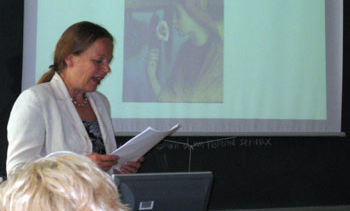
Pirjo Lytikäinen
After the conference, on August 16, many of the conference-goers participated in the excursion to Hvitträsk, the spot where Finnish architects Eliel Saarinen, Herman Gesellius, and Armas Lindgren created a lakeside retreat between 1901 and 1904 in Kirkkonummi, about eighteen miles from Helsinki. The unique complex, consisting of two large houses and extensive gardens, itself called Hvitträsk (“White Marsh” in English), represents an original combination of Bauhaus, Art Nouveau, Craftsman and Finnish design. It has been preserved and transformed into a kind of museum which we visited with great interest. We were also able to walk through the misty forest down to the lake Vitträsk, where a sauna cabin is located and a small pier. The group enjoyed yet another fabulous lunch, Finnish style, around a large table in the Hvitträsk Fireplace room. Once again, we raised our wine glasses, making toasts in a variety of languages to new and old friends, thus bringing to an end yet another AIZEN conference in an atmosphere of conviviality and shared scholarly interests.
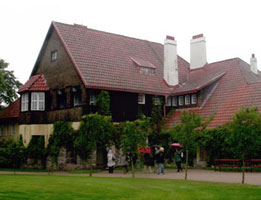
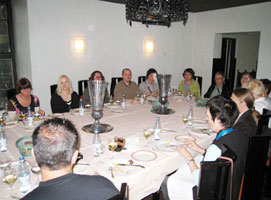
Left: Excursion to Hvitträsk
Right: Lunch at Hvitträsk
Achievements by AIZEN Members
We have achievements to report for a number of AIZEN members.
Christian Mbarga has published a book entitled Émile Zola: les femmes au pouvoir dans Les Rougon-Macquart (Paris: L’Harmattan, 2008), in which he explores powerful female figures in Zola’s first novel series. In Mbarga’s account, these figures are responsible for an uncanny reverse image of contemporary society that takes shape. Zola’s female characters often exhibit a kind of strength that enables them to dominate in a world where man visibly held sway, thus revealing their primordial role.
Juan Pablo Spicer-Escalante (in collaboration with Lara Anderson) has edited a collection entitled Au Naturel: (Re)Reading Hispanic Naturalism (Cambridge Scholars Publishing, 2010). The essays revisit Hispanic naturalism, demonstrating the ways in which these literary and filmic texts continue to engage the social problems that have affected the Hispanic world from the nineteenth century to the present day.
A book has come out by another of our members, Éléonore Reverzy, with the title Nana d’Émile Zola (Paris: Gallimard, 2008). In this work (part of the collection “Foliothèque”), the author provides an in-depth and up-dated reading of the classical naturalist text for university students, accompanied by a bibliography, a chronology, notes including variants, testimonies, and press releases. It opens up new areas of inquiry and research for assiduous readers of this novel.
Catherine Dousteyssier-Khoze and Edward Welch have edited a collection entitled Naturalisme et excès visuels: Pantomime, Parodie, Image, Fête. Mélanges en l’honneur de David Baguley (Newcastle upon Tyne: Cambridge Scholars Publishing, 2009), with a preface by Henri Mitterand. The essayists shed new light on the naturalist esthetics, examining certain energizing focal points related to visual excess. Among the contributors to this volume are a number of AIZEN members, in addition to Catherine Dousteyssier-Khoze: Anna Gural-Migdal, Chantal Morel, and Alain Pagès.
Alain Pagès has edited an important collection of papers given during the ceremony that took place in 2008 in Paris commemorating the centenary of the transfer of Zola’s remains to the Panthéon. This work features essays dealing with two main areas of Zola studies: the politics and ideology that informed the Dreyfus struggle of 1906-1908 and Zola’s literary legacy from 1908 to the present: Zola au Panthéon : L’épilogue de l’affaire Dreyfus (Paris: Presses Sorbonne nouvelle, 2010. The contributions brought together in this volume trace the dynamic story of Zola’s “Pantheon-ization”. They analyze the political and ideological stakes of an event that can be considered the true epilogue to the Dreyfus Affair. They offer a reflection on the reception of this writer whose posthumous destiny was thereby transformed.
We are proud to announce, too, Volume XXIII (2008) of Excavatio. This is a special issue, featuring “Female Representations in Nineteenth-Century French and Scandinavian Realism and Naturalism.” A section entitled “Realism, Naturalism Decadentism” opens the volume, followed by “Problematics of Female Representation in French and Scandinavian Realism and Naturalism” and “The Trappings and Implications of Femininity in French Naturalist Texts”; the volume concludes with a section entitled “The Constructedness of Naturalist and Decadent Women.” All articles previously published in Excavatio will soon be available in electronic format on the AIZEN website.
Developments in the Area of Fine Arts
In the area of Fine Arts, we have a few new developments to report. An art book has come out, with 51 full-colour illustrations, reproductions of paintings by Réné Marcil, a contemporary artist from Québec, Canada: Marcil & Émile Zola: Nana, by Robert J. Langevin (Toronto: Waddington’s Publishing, 2008). This bi-lingual album brings together bright, energetic, erotically charged paintings and excerpts from Zola’s Nana. The neo-expressionist work by Marcil, in this catalogue prepared for one of Canada’s most significant auction houses, updates Zola and naturalism for a more contemporary context.
See: http://www.renemarcil.com/Publications.html

A Green Cat and his Beautiful Mistress by René Marcil
Furthermore, some steps have been taken toward the erection of a new statue of Emile Zola in the 15ème arrondissement of Paris. Since 1924 a bronze statue of Zola, created by Constantin Mercier and Alexandre Charpentier, stood on that spot, until the German army, in 1941, dismantled and melted it down. In 2006, Gilles Alayrac, Conseiller de Paris (15ème arrondissement) and Conseiller régional de l’Ile de France, took charge of the project for a new statue to be sculpted of pink granite by Israeli sculptor Shelomo Selinger, who has a particular affinity for this work.
Originally from Poland, Selinger was deported at age 13½ to several different concentration camps, before his liberation by the Russians in 1945. After having fought for the establishment of the State of Israel, he moved to France in 1956, where he studied Fine Arts. He has gained international recognition for a number of works, including the memorial to those sent to concentration camps from France, in Drancy, and “La Danse” in the gardens of La Défense, in Paris. He is an Officier de la Légion d’Honneur.
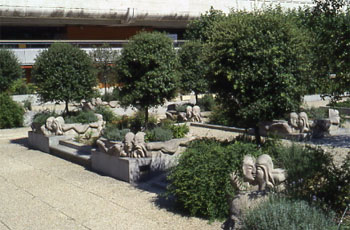
La Danse by Shelomo Selinger
The new statue of Zola is to be erected in the same location as the earlier one. M. Gilles Alayrac would like the members of the AIZEN to be apprised of this project, with the hope that many will lend their support in one way or another. In order to make a donation, you will need to have a bank draft made up, in euros, to the order of “Zola Sculpture.” Send it to the following address:
Zola Sculpture
6 rue Dulac
75015 Paris
France
For more information, you may write to this electronic address: asso@zolasculpture.org
We thank Dr. Brigitte Émile-Zola for providing this information and encouraging the AIZEN’s support of this project.
And, finally, a collection of about 141 paintings by early 20th century artists, including Picasso, Cézanne and Dérain, has recently come to light, after remaining untouched for forty years in the vault of a Société générale bank in Paris. When the dealer, Ambroise Vollard, died in 1939, his assistant Erich Slomovic put them in the bank and then fled to Yugoslavia where he was killed by the Nazis in 1942. In 1979, the bank was allowed to open the vault and sell the paintings in order to recoup unpaid storage fees. In 2006, an ownership dispute was finally resolved and the paintings will be put up for auction at Sotheby’s in Paris on June 29, 2010, where they are expected to fetch close to 20 million euros. Of interest to us is the fact that among these paintings is a little known painting by Cézanne, titled Portrait d’Émile Zola.

Portrait d’Émile Zola by Cézanne
A Final Word
It will be a joy for us to meet our members in Pusan, many of whom have become authorities in Zola and/or naturalism, as well as make the acquaintance of specialists in the field from Asia and Australia who will join our ranks as new members. This will be a grandiose and dazzling event, with homage paid to the AIZEN and its entire team. A special tribute will be given to Professor Anna-Gural Migdal of the University of Alberta, for all that she has done for this Association and Zola Studies. We quote Professor Mario Petrone from Italy, one of our illustrious members, who exclaimed to our President when he attended the conference in Edmonton: “Tout ce que vous avez fait par l’AIZEN et pour l’AIZEN mérite de passer à l’histoire!”
Anna Gural-Migdal and Carolyn Snipes-Hoyt, June 2010.
AIZEN/UNIVERSITY OF HELSINKI CONFERENCE PORTFOLIO 2008
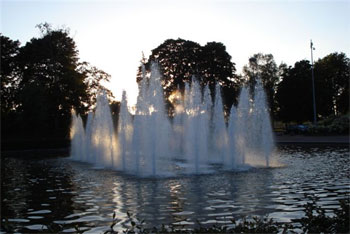
Park behind Hotel Arthur, Helsinki
Chères Anna et Riikka,
Comment rendre compte de mes expériences finlandaises? Bien sûr, tout d’abord, en vous remerciant encore une fois pour tout le travail que vous avez fait, pour l’accueil chaleureux et le déroulement parfait du colloque. Mais il y a autre chose et je crois que la photo ci-jointe, que j’ai prise le soir de mon arrivée dans le parc derrière l’hôtel Arthur, l’exprime très bien:
- la lumière que les participants et participantes ont jetée sur les différentes littératures, ce qui m’a fait découvrir de nouveaux horizons;
- le mystère des arbres et des forêts scandinaves, dont il a souvent été question et que j’aime beaucoup;
- l’ambiance chaleureuse dans laquelle nous avons travaillé et qui m’a fait du bien;
- le moment de détente qu’a été pour moi ce colloque après des mois et des mois de travail;
- la pureté de l’air finlandais que j’ai retrouvée, au sens figuré, dans la sincérité et l’amitié des collègues.
Bref, c’était inoubliable! Un grand bravo pour Anna, “l’aïeule'” de notre famille naturaliste et un autre pour Riikka, la digne représentante de la “branche'” finlandaise!
Marjolein van Tooren, VU University Amsterdam, The Netherlands
Chères Anna et Riikka
Un grand bravo à toutes les deux pour tous les efforts que vous avez fournis pour faire de ce colloque un véritable succès. Je garderai un excellent souvenir tant des présentations que nous avons entendues que du cadre de la conférence et du chaleureux accueil fait aux participants.
Mon seul regret: ne pas avoir pu rester plus longtemps à Helsinki!
Bien amicalement,
Marie-Sophie Armstrong, Lehigh University, USA
Dear Anna,
Thank you for another wonderful AIZEN conference, one which reached and exceeded the highest expectations of such events - which are to replenish intellectual energy, to reaffirm the contemporary importance of the authors we continue to explore, and to renew contact between colleagues and friends. It was a wholly fulfilling week, and it was lovely to see you again.
Dear Riikka,
A quick word from Canada to say how very much I appreciated both the conference and the tremendous welcome you gave us in Helsinki earlier this month. The event was notable not only for the high quality of the conference itself, but also for the spirit of friendship, goodwill and shared interest that permeated the entire week. I returned to Canada inspired by all the presentations, and with a new interest in Scandinavian naturalism, about which I look forward to learning much more.
You looked after us exceedingly well. I boarded my flight out of Helsinki with a strong impression that I had seen something of the real Finland, and with an even stronger desire to return with my family, to learn more of Finnish culture and to see more of the beautiful countryside. To feel so replete (intellectually, gastronomically and spiritually!) at the end of a short conference trip is a rare experience indeed, for which many, many thanks to you.
Jeremy Worth, The University of Windsor, Canada

From left: Marie-Sophie Armstrong, Jeremy Worth, and Marjolein van Tooren
Chères Anna et Riikka,
Je voulais vous remercier de tout cœur de m’avoir donné la possibilité de participer au Colloque AIZEN, “Women under Construction”, en m’accueillant généreusement à Helsinki, une ville que je n’ai pas pu visiter comme je l’aurais voulu (hélas!) mais où je reviendrais avec plaisir…
L’intérêt des communications, toutes excellentes, conjugué à l’atmosphère très agréable de ces deux journées de Colloque, m’ont fait passer des moments inoubliables…
Tout cela me convainc encore plus (s’il en était besoin!) du grand professionnalisme d’une association comme l’AIZEN.
Domenica De Falco, Université de Naples, Italie
Très chères amies, l’une, de l’autre côté de la Baltique, l’autre, de l’Atlantique,
En retrouvant Strasbourg, je m’empresse de vous remercier de m’avoir invitée à ce magnifique colloque, qui a compté tant de moments précieux. Précieux tant pour la qualité scientifique du Colloque que pour les échanges, et l’amitié. Sans parler d’une organisation imparable. J’espère que Zola nous donnera d’autres occasions de rencontres, et aussi vos passages en France.
En amitié,
Éléonore Reverzy, Université Marc Bloch-Strasbourg II, France
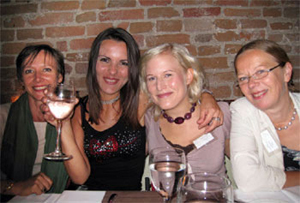
From left: Éléonore Reverzy, Domenica De Falco, Riikka Rossi, and Pirjo Lyytikäinen
Dear Professor Anna Gural-Migdal!
It was a pleasure for me to have the possibility of participating in the conference and to meet many interesting people coming from so many different countries. As a scholar who has specialized in Finnish literature, I learned much about Zolian naturalism and, of course, I enjoyed the lively discussions.
Everything went so smoothly, and the “naturalist dinner” in Kappeli was excellent.
Many thanks to the entire Organizational Committee!
Yours sincerely,
Päivi Lappalainen, University of Turku, Finland
Dear Anna,
It was a pleasure to participate in such a well-organized and interesting conference. All the papers provided food for thought and many of them opened my eyes to new things. I have already started tracking down some of the participants’ writings to get to know more. And our Finnish hosts were extremely helpful, going out of their way to make the stay in Helsinki enjoyable.
With best wishes,
Auður Aðalsteinsdόttir, University of Iceland, Iceland

From left: Laura Forsström,Auður Aðalsteinsdόttir, Virve Miettinen, and Päivi Lappalainen
Chère Anna,
Un bien grand merci pour une conférence très réussie!
Bien cordialement,
Morten
Chère Riikka,
Pour moi la participation au colloque a été un vrai plaisir, avec des collègues très sympathiques et un excellent programme (chargé!). Je te félicite d’une organisation parfaite; vraiment, on ne peut mieux faire. Tout a été préparé avec soin, et il n’y a eu aucun pépin. Bref, l’idéal!
Bien à toi,
Morten Nøjgaard, University of Odense, Denmark
Dear Anna,
I thoroughly enjoyed the conference, and meeting everyone, and wish I had more time to mention the many great aspects of the conference here, but time presses, so I’ll just say that I hope I’ll have another chance again in the future.
With best wishes,
Melanie Hawthorne, Texas A&M University, USA
Chères Anna et Riikka,
Un très très grand merci pour une excellente conférence et la belle journée que nous avons passée ensemble à Tallin.
J’en garderai un merveilleux souvenir…
Je vous embrasse toutes les deux,
Julia Przybos, Hunter College and the Graduate Center, CUNY, USA
Chère Anna!
Merci encore pour ce très, très beau colloque à Helsinki!! Beau, sympathique, et amusant!
En plus d’avoir passé un très bon moment j’ai appris beaucoup de choses intéressantes notamment sur Zola et sur le naturalisme.
A bientôt, j’espère...
Cordialement ,
Guri Ellen Barstad, University of Tromsø, Norway
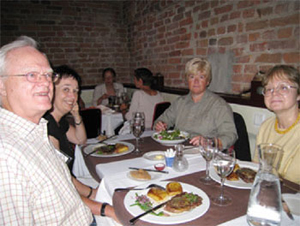
From left: Morten Nøjgaard, Guri Ellen Barstad, Melanie Hawthorne, and Julia Przybos
Dear Anna,
Just to say warm thanks to you and your co-organizers, especially Riikka and Carolyn for an intellectually excellent, cordial and very convivial conference.
Hope you are feeling better after some rest and relaxation. Have a good trip home!
Best wishes,
Susan Harrow, University of Bristol, England
Dear all,
I would like to congratulate Dr. Anna Gural-Migdal, Dr. Riikka Rossi, Dr. Carolyn Snipes-Hoyt, and Virve Miettinen for organizing such an inspirational and successful conference in Helsinki, Finland. It was a unique and special conference that has gathered scholars from different parts of the world. Not only has it broadened my horizons in 19th Century Literature, but also in Scandinavian literature.
I am also impressed by the great hospitality shown by the Department of Finnish Language and Literature at the University of Helsinki. I have to thank the organizers once again for accepting me into the conference, allowing me the opportunity to meet with fellow researchers, to appreciate their high caliber research and to bring me that far to Helsinki, a trip that I will never forget!
Lisa Ng, University of Calgary, Canada
Dear Anna,
I really enjoyed the conference in Helsinki. It was great to see you again and thanks to all your hard work and organisation, things ran as smoothly as clockwork.
Wishing you all the best for the academic year to come.
Danielle Bishop, University of Plymouth, England
Chère Anna,
A tremendous thanks for a truly lovely conference. It was a real pleasure to have so many wonderful opportunities to discuss nineteenth-century women with colleagues from all over the world!
C’était formidable, merci.
Je t’embrasse,
Elizabeth
Dear Riikka,
Many thanks for a truly lovely conference. Everything was splendid, from the conference organization itself and the rooms in which we met to the lovely coffees, lunches, and magnificent Kappeli banquet. I very much appreciated the fine intellectual content of the presentations and especially your kindness as hostess.
I look forward to seeing you again soon!
Warmly,
Elizabeth Emery, Montclair State University, USAChère Riikka,
Je te remercie de tout cœur pour un colloque très réussi à tous les niveaux. L’idée d’établir pour ce colloque un rapprochement entre les réalismes/naturalismes scandinaves et français, avec des chercheurs et chercheuses des deux côtés de l’Atlantique, était géniale!
Toi et Anna, vous avez réalisé cette idée de façon très efficace...
Les activités des deux journées se sont déroulées sans heurt. Les présentations étaient audacieuses et d’une profondeur exceptionnelle, se prêtant ainsi à une discussion stimulante. En somme, sur le plan de la qualité scientifique, le colloque était excellent.
Comme invitée d’honneur, je suis très reconnaissante envers l’administration de l’Université de Helsinki, du Département de langue et littérature finnoises et, en particulier, du Département des études graduées en littérature pour leur générosité.
Par ailleurs, Riikka, la gentillesse de tes collaboratrices a été remarquable. Il faut le dire, dans le choix des restaurants et l’organisation de l’excursion, vous, les Finnoises, vous vous êtes montrées d’un goût impeccable. Je pense que je parle pour tous les participants du colloque, quand je dis que nous avons vraiment été impressionnés par l’accueil très chaleureux en Finlande. Un grand merci à toutes!
Amicalement,
Carolyn Snipes-Hoyt, Pacific Union College, USA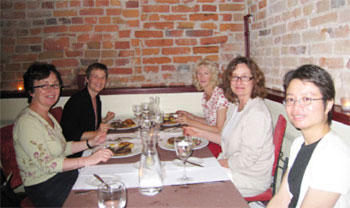
From left: Susan Harrow, Elizabeth Emery, Danielle Bishop, Carolyn Snipes-Hoyt, and Lisa Ng
Chères Anna et Riikka,
Je tiens à vous remercier pour cet excellent colloque AIZEN qui vient de se dérouler à Helsinki. J’en garderai un très bon souvenir. Chapeaux bas pour l’organisation! J’ai beaucoup apprécié la qualité des intervenants et votre accueil chaleureux. Je garderai également un beau souvenir de mon séjour en Finlande que je voudrais découvrir davantage un jour.
Kiitos paljon. Merci encore une fois!
Amitiés, Agnieszka Tworek, Middlebury College, USA
